SS RAAJAMOULI’S BAAHUBALI: THE BEGINNING opened in theatres on 10 July last year, in a season overcast with the muscular release of Yash Raj Films’Bajrangi Bhaijaan, starring Salman Khan. Baahubali, featuring the Telugu stars Prabhas and Rana Daggubati in lead roles, came with one of the biggest budgets of any Indian film (Rs 175 crore), the promise of spectacular vistas on screen, and a Bollywood endorsement by the big cheese Karan Johar, who purchased the Hindi rights of the movie. Its reviews were rapturous.
Rajamouli had already won terrific acclaim for his previous film, Eega; but Baahubali, with an upcoming sequel, was touted as his masterwork. The story is a revenge drama of two warring princes, played out over two generations, bolstered by special effects of much beauty, and competent, even if overplayed, performances. Box office collections raced to Rs 236 crore in the film’s first six days, only narrowly eclipsed by Bajrangi Bhaijaan’s Rs 238 crore for the same period.
The first note of discomfiture in the English-language press was struck by Anna MM Vetticad, a film critic and writer, who noted that Baahubali contained some troubling sexism. The second, more resounding note, was struck by the former editor-in-chief of the Indian Express Shekhar Gupta, who called the film out on its troubling politics of tribal identity. Gupta, who is given to emphatic pronouncements, tweeted: “Most awful film portrayal of tribals in #Bahubali. Dark, scar-faced, ugly rapist brutes with rotting black teeth. Shameful profiling.”
His tweet was received with a chorus of absurdities. One Twitter user called him a “social terrorist,” another warned him not to watch the movie Jurassic Park, and several called him a Congress “presstitute” for picking faults with a “Hindu” film. Some pointed to the fact that the terms “tribal” or “adivasi” were never actually used in the film. This is true, at least in the Hindi version that I viewed. But it is undeniable that the film uses common cliches that have often been associated with tribal identity. In the film, these tribal cultures are presented in contrast to that of the king Baahubali’s kingdom of Mahishmati, with its immense architecture, gold-bordered saris and dhotis, and elaborate war strategy articulated in Sanskritic terms like “trishul vyuh.”
There are actually two tribal communities in the film. One is the unnamed community that raises Baahubali’s son, the imperilled prince Shivudu. These people worship the deity Shiva, but they wear chunky jewellery, while the women also tie their hair off-centre and wear no blouses—all classic markers of tribal people in Indian cinema. This is friendly profiling.
The other kingdom is that of Kalakeya, whose inhabitants—the ones Gupta described in his tweet—are of blackened face, bulging eyes, and questionable personal hygiene. They wear sleeveless costumes with rudimentary buttons, and also speak a separate language, Kilikili, which was created for the film by the Tamil lyricist Madhan Karky. Kilikili is never subtitled—at least not in the Hindi version of the film I saw. In other words, it is not deemed worthy of translation, and is denied recognition. All of this is shorthand for the uncivilised, the unrefined, the unclean. When physical features are used as code for identity—and especially when these are signalled as ugly—it is racism. It is curious that the Kalakeya people were conceived of for a Telugu film, considering that south India has seen political movements criticising the demonisation of the region’s people by the Aryans of north India.
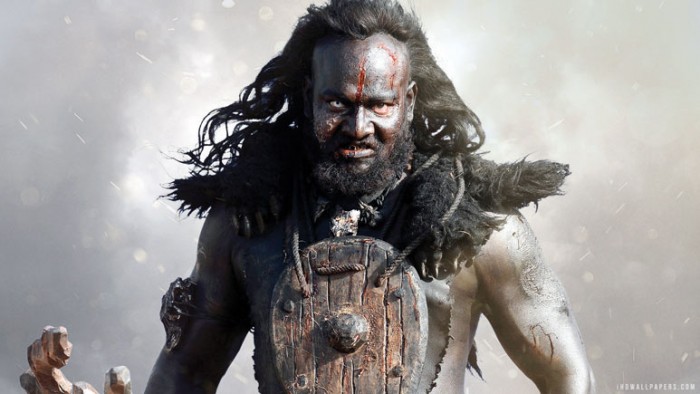
A Kalakeya warrior in the film Baahubali. A very very problematic depiction of the tribal “savage”
The bloodthirsty tribal person is, in fact, primarily a Hollywood trope. In American movies—such as the Tarzan films, which began appearing in the 1930s; the John Wayne western tradition, includingStagecoach (1939) and The Searchers (1956); and the Indiana Jones franchise of the 1980s—tribal communities are death cults that worship skulls in suitably dungeon-like quarters, or lance-wielding savages promising murder to outsiders captured in the forest. Of course, the American hero—Jones, Wayne or Tarzan—puts a stop to this bad behaviour, often through acts of violence.
Bollywood, however, took its cues from British colonial anthropology and the works of writers such as Rudyard Kipling, who typically represented tribal people as superstitious and foolish, but essentially good folk—so-called “noble savages.” In films such as 1954’s Nagin and 1958’s Madhumati, Bollywood exoticised and simplified the tribal person as the “child of the earth.”
The term “tribal” was introduced into India by British colonial administrators, but remains firmly in use today. The Indian constitution lists hundreds of different communities as such, in order to grant them affirmative action. The film-studies scholar Suneeti Rekhari noted that the government, in 1951, defined tribal status by “tribal origin, primitive way of life, remote habitation, and general backwardness in all regions.” As a category, “tribal” flattens a vast diversity of cultures and identities into one generic descriptor, but—in matters of media representation—it has acquired a certain set of stock tropes. It is this broad understanding of the term that I work with in this essay.
I have used “tribal,” and not “adivasi,” except where a character has been specifically identified as the latter. In his paper ‘Adivasis, Naxalites and Indian Democracy,’ the historian and writer Ramachandra Guha noted that the term “adivasi” is used for the tribes of central and eastern India, not the north-eastern tribes who have, historically, been less shaped by Hindu influence, and have not suffered displacement by development projects to the extent that tribes in the mainland have. In the past half decade or so, however, the politics and aesthetics of tribal identity in Hindi movies have become markedly more sophisticated—to say nothing of the fact that there are more films that feature tribal characters than earlier. This essay will focus on four films, released in the past seven years, which feature complex depictions of tribal heroes: 3 Idiots, Raavan, Veer and Mary Kom. In 3 Idiots, released in 2009, Aamir Khan plays a character called Phunsukh Wangdu, from Ladakh. Abhishek Bachchan is Beera Munda, the main character in 2010’s Raavan, and Salman Khan is a Pindari tribal warrior in the title role of Veer, also released that year. (Little is known about the Pindaris other than that they were a community of marauders extant during the period of the Maratha empire, from the seventeenth to the nineteenth century; nevertheless, the film constructs the Pindaris as a tribe, with a distinct culture.) In the 2014 biopic Mary Kom, Priyanka Chopra essays the role of the champion boxer.
In the past six years, there have been nearly as many films with tribal heroes as there have been, by Rekhari’s count, in the 53 years from 1954 to 2007. She notes five films with tribal characters across a span of 53 years. Her list includes the 2007 sports movie Chak De! India, in which two tribal characters, Molly and Mary Zimick, have, at best, three scenes with dialogue.
The tribal character was a figure rarely met in Hindi cinema. Encountered, yes; met, no. We’ve seen them dancing and singing often enough; they usually bring terrific energy, erotic costumes and, always, their drums, to the proceedings. In a 2009 paper called ‘Jungle Love: Exposure and Erasure in Hindi Cinema’s “Tribal Numbers,”’ the ethnographer and film scholar William Elison noted that the tribal song-and-dance performance, or “tribal number,” was “part of the palate of standard flavours in the masala of the Forties, Fifties, and Sixties.” But after the song and dance ended, we were almost never introduced to a single tribal character as a person who might speak, think or feel. (Neither is the tribal identity the only one so marginalised by Bollywood: a recent statistical investigation by The Hindu found only six backward-caste heroes in nearly 300 films released over 2013 and 2014. The Dalit is even rarer, and owes his or her Bollywood existence almost entirely to Prakash Jha’s recent filmography. The default setting of a Bollywood film is the upper-caste Hindu milieu.)
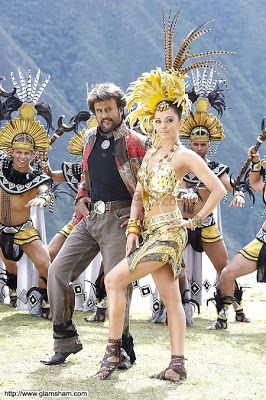
Rajinikanth and Aishwarya Rai in the marvellous song Kilimanjaro in Robot. Check out those feathers!
Wittingly or unwittingly, this new batch of films comes during the ongoing political moment of “reclaiming the tribal person” within the Hindu fold. The term “ghar wapasi” has gained currency since the election of Prime Minister Narendra Modi of the Hindu nationalist Bharatiya Janata Party, though the Rashtriya Swayamsevak Sangh has been running schools in tribal areas across the country for at least the past 37 years.
Further, three of these films released between December 2009 and summer 2010, when national anxieties about the Maoist Naxal movement—and by association, many tribal communities—ran high. In that year, the prime minister, Manmohan Singh, termed Naxalism “the greatest internal security threat to our country.” In her paper ‘Guns and Protests: Media Priorities in Chhattisgarh,’ the journalist Supriya Sharma quoted a study by the Norway Peace Research Institute conducted across 150 districts in six states in India: the principal finding of this study was that the Maoist insurgency is “strongly-correlated” to the presence of poor tribal and low-caste communities.
The increasing interest in tribal characters might be mere coincidence, but the timing is of interest. None of this, though, is to say that the tribal hero has arrived in Bollywood, or that the new crop of characters represents the acceptance of the tribal character in the industry. The films and characters are too few to describe as a pattern—this is not, in that sense, a trend story. This is, if anything, a trickle story: an exploration of the new ways of understanding and representing the tribal identity, previously relegated to the song-and dance routine of the tribal number. Who is this new tribal hero in Bollywood? Is he or she a departure from the old trope? Or, have some things remained the same despite a semblance of change?
In her paper ‘Jaisa Desh Waisa Vesh? Explorations on the Representations of Adivasis in Popular Hindi Cinema,’ Rekhari offers an excellent, compact review of significant representations of tribal people in Bollywood from 1954 to 2007. She discusses five films across a period of 53 years—Nagin (1954),Madhumati (1958), Yeh Gulistan Hamara (1972), Lal Salaam (2002) and Chak De! India (2007). Tribal people feature as central characters in the first four of these, and as supporting characters in Chak De! India.
Nagin starred Vyjayanthimala Bali and Pradeep Kumar as tribal snake catchers. It is set in a forest landscape that often looks ominous in the faded black and white of the film’s print. The film boasts an acclaimed musical score by Hemant Kumar. The song ‘Mann doley mera tann doley,’ in particular, was a hit that is associated with a marvellous, unverifiable story—a reviewer in The Hindu mentions that theatre owners screening the film asked snake charmers to remain alert in case the song drew in snakes from the neighbourhood. Given that many more snake dance numbers followed in the next few years, this song probably established them as a Bollywood motif. Song and dance played a big part inNagin’s success—the 18-year-old Vyjayanthimala Bali was cast for her dancing skills—and the tribal people were portrayed as singing, dancing primitives.
In Madhumati, Dilip Kumar’s character hears Bali’s character sing, and falls promptly in love with her. He is the manager of a timber estate, and she a tribal woman from the forests providing the timber. But Kumar’s character’s employer also has designs on her virtue, and one day she disappears; the film traces the mystery of her disappearance. Bali’s character’s persona evokes the beauty, mystery and organicity of the forests. The film, which was a runaway success at the box office and later inspired the 2007 blockbuster Om Shanti Om, also boasts a superb score by Salil Chowdhury. ‘Bichua’ remains perhaps one of the best-known tribal numbers in Hindi cinema.
Yeh Gulistan Hamara has a similar “nature’s child” narrative for the tribal heroine. Sharmila Tagore plays a girl from the Ao tribe in the north-eastern hills, who is part of the cadre of an evil local leader. Dev Anand, an engineer, arrives in her village to construct a bridge to mainland India. They fall in love. Loyalties change. Tagore’s allegiance shifts from her tribal chieftain to the Indian nation.
The film Chak De! India features two tribal girls from the north-east in peripheral roles. The film offers one line in a song as background to their characters: “North-east ki taazgi inki aan baan aur shaan hai” (the freshness of the north-east is their honour and their pride). Lal Salaam is about a young couple in a remote forest area, whose ideologies bring them into conflict: Nandita Das is a Naxal activist, and Sharad Kapoor believes in non-violence. In Rekhari’s analysis, only Lal Salaam fleshes out its tribal characters to their full human scope, not using stereotypes in their depiction, or in their eventual destinies. But I disagree with Rekhari that this is a Bollywood film—in sensibility and casting, it is a multiplex project that slipped away just before the multiplex came into its own.
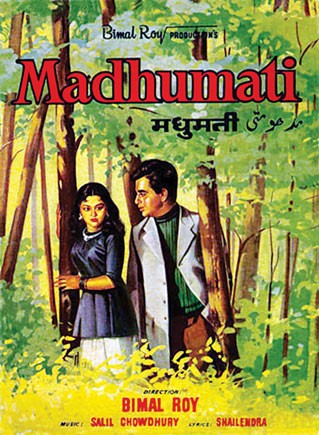
A poster of the film Madhumati, where Vyajayanthimala Bali played the role of a tribal girl (in one of her characters)
Rekhari’s analysis omits, perhaps with reason, one figure that was a constant in older Hindi cinema—the banjaran, or the “gypsy” girl. It is largely the gypsy girl who figures as a character, not so much the gypsy boy, or the banjara. The Banjara, a nomadic community with roots in Rajasthan, appear on the Scheduled Tribes list in only four states in India—an ambiguity reflected in their Bollywood status. The banjaran appeared as a prominent character in a number of hit films in the 1970s, such as Caravan(1971), Seeta aur Geeta (1972) and Zanjeer (1973)—as well as others, such as the eponymous Banjaran(1991).
The banjaran is unmistakably an exotic thing—typically costumed in a colourful skirt-blouse, with plenty of street smarts, and a sexy confidence. She is usually a working woman—a performer, which accounts for her confidence and energetic dance moves. She likes to make the first move in romantic matters—it could be as small a thing as putting four spoons of sugar in a glass of tea, as Zanjeer’s knife-sharpening street performer, played by Jaya Bachchan, does. In this, the banjaran is clearly shown as different from a traditional good girl—the distinction clearest in Caravan between Aruna Irani’s headstrong banjaran, Nisha, and Asha Parekh’s quiet Sunita.
But Bollywood banjarans were not unambiguously marked as “the other” in the movies’ social order. They were, after all, acceptable as romantic partners—Hema Malini’s Geeta gets Sanjeev Kumar inSeeta aur Geeta. The central distinction from the tribal character may have been that banjaras, by their very definition, were not rooted to the natural landscape. Once that child-of-the-earth connotation was gone, how different could they be from the migrants who make up the Bombay of the movies of that time? In fact, the banjaran could even be the equivalent to the tramp in the city, with one difference. The male tramp arrived entirely alone—a child of the industrial age, which brought so many to the city in search of work. The banjaran came to the city, not on her own—perhaps because then her sexuality would be wholly uncontrolled—but with a band of people from her community.
Leaving aside this character type, there are a couple of films Rekhari misses. In 1978’s Satyam Shivam Sundaram, Zeenat Aman plays a tribal girl who sings like a spell. Shashi Kapoor, an engineer, comes to work in the area, hears her sing, and marries her for her voice, not knowing that her face is half-scarred by burns from an accident. Horrified by her disfigurement, he spurns her churlishly. Aman’s character endures the humiliation at home, but dresses sexily to go out into the forest, and seduces Kapoor. Puzzlingly, he manages not to recognise his wife and falls in love again. The film takes place in a landscape of an unspecified location, but the setting’s woods, lake and temple give it the appearance of the heartland of Madhya Pradesh.
In all these films, the tribal identity is marked by a standard set of attributes—an organic goodness, an unspoilt spontaneity, an innate simplicity—the sum of which typically leads to tragedy or some serious trouble. This profile, according to Rekhari, borrows from the concept of the tribal in colonial anthropology and the post-colonial development discourse. Bollywood has on occasion projected the tribal person as a bloodthirsty savage—we see this in the Tarzan-inspired Zimbo Ka Beta (1966) andAdventures of Tarzan (1985). But this is unusual, and likely influenced by the Tarzan narrativeimported from Hollywood.
The landscape that these tribal characters occupy also usually falls into British anthropological categories. These included “hill and forest” tribes, and “remote” tribes, who occupied, say, the desert or the deep jungle. Lead characters in Hindi movies have a long history of visiting hill, forest and desert landscapes. But the tribal hero or heroine is native to these landscapes. And the manner in which they are shot extensively against these backdrops—such as in the songs of Madhumati—reflects how landscape is used to configure identity. In classic Hindi cinema, they were identified intimately with these landscapes. This is something that has become even more emphatic in the recent films—in Veer,Raavan, 3 Idiots and Mary Kom, the protagonists’ identities are still intimately tied to the hill, forest, or desert regions they come from.
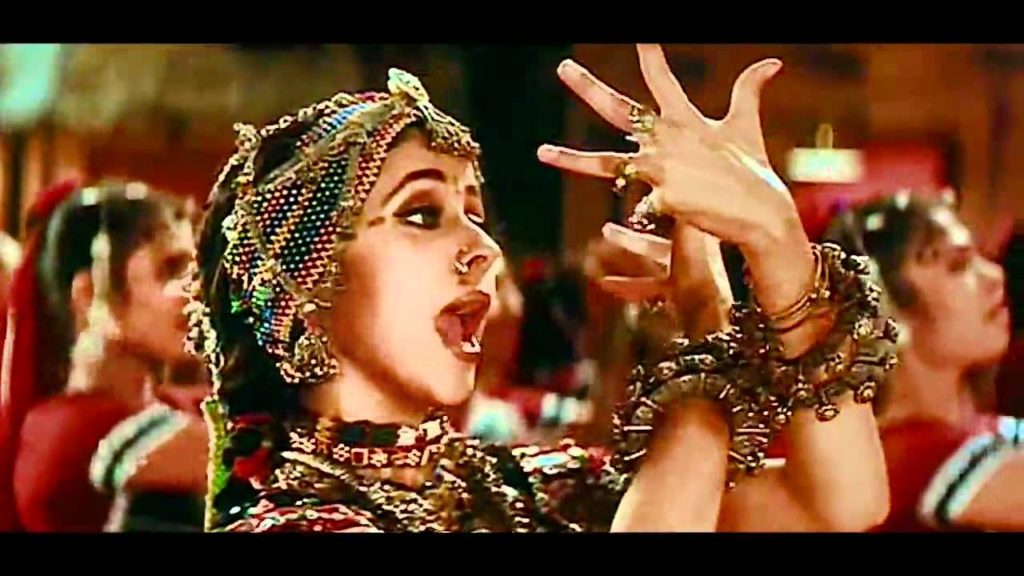
Urmila Matondkar in the ’90s smash hit song, Chhamma Chhamma. See the distinctive headdress and the chunky jewellery?
Another tribal motif in Bollywood is the tribal number, which, Elison notes, is identified by three markers: distinct language, dress, and “eroticised performance.” The last two are self-explanatory. A look at any well-known tribal number, say ‘Mann doley mera tann doley’ in Nagin, ‘Ramaiya vastavaiya’ in Shree 420, or ‘Bhor bhaye panghat pe’ in Satyam Shivam Sundaram, will make clear the distinct costuming, which includes chunky jewellery and frequent blouselessness. The performances are markedly sexualised. All these attributes are visible well into the 1990s—consider ‘Chhaiyya chhaiyya’ in Dil Se (1997) and ‘Chhamma chhamma’ in China Gate (1998).
The marker of a distinct language refers to the fact that refrains in tribal numbers often appear to Hindi speakers to be gibberish: say, the words “Ramaiya vastavaiya,” or “Nake mukhe chun kali” in the song ‘Gup chup pyaar karen’ in Sazaa (1951). But many speakers of Indian languages would recognise—as Elison and Gayatri Chatterjee noted in a 2009 paper—that these “gibberish” words are often just in a language different from Hindi: “Ramaiyya vastavaiyya” is Telugu for “Ramaiyya, will you come?” and “nake mukhe chun kali” is Bengali, and means “lime and ink on your nose and face.”
In his seminal treatise, the scholar Edward Said argued that Orientalism was about differentiating between the “familiar (Europe, the West, us) and the strange (the Orient, the East, them).” The design of the tribal number conforms to Said’s formulation of how this discourse is constructed. It essentially works to exoticise, and sexualise, the tribal person—setting him or her up as the other, distinct from our collective self.

Priyanka Chopra in and as Mary Kom (2014)
All four of the newer films step away from this template. The tribal protagonist, shedding visible markers of her identity, is now emphatically projected as “one of us,” a proud member of the Indian nation. By far, Mary Kom embodies both these threads the most strongly among these films. In fact, it eschews visual codes of representation to the extent that it cast in its lead role Priyanka Chopra, who looks as much like the real-world champion boxer Mary Kom as Punjab looks like Mizoram. (Naturally, commercial considerations were central to this choice.) I watched Mary Kom amid a storm of complaints over Chopra’s casting, and was surprised by its brisk and moving narrative—though the film was not without problems.
The producers of the film paid close attention to the details of setting and props. There are few feathered head-dresses, there is no drum-thumping, no mention of exotic liquor or meat. Some care has clearly been taken with the costuming and sets: in a story in the Indian Express, the film’s director, Omung Kumar, and his wife, Vanita, who is credited with the production design, recounted how they sourced everything movable—“fabrics, stools, chatais, matchboxes”—from Manipur. But these details are not immediately apparent while watching the film; they are footnotes to the story, rather than signposts.
The film is set in the Imphal hills where Kom lives (although it was shot in Dharamsala). This by itself says nothing except the obvious—that the film correctly notes a biographical detail. But the use of landscape in the song ‘Salaam India,’ which plays over a montage of Kom training for her comeback, is revealing. Here, she is framed against a background of harsh mountains, tall trees, and brisk, clean streams. The suggestion is strong that she is as tough, as invincible as the terrain. Compare this with another training song, the title track of Bhaag Milkha Bhaag, a 2009 biopic about the Olympian runner Milkha Singh. There, the camera remains focussed on Farhan Akhtar’s physique, while the background quickly morphs away from severe mountains to the stands in a stadium.
There are only two ritual sequences in the film. One is Kom’s lovingly filmed Christian wedding, and the other is a tribal celebration held when Kom returns victorious from a tournament, but this is short and muted. It’s also perhaps the film’s only mention of her tribal identity. Significantly, Kom wears her India blazer over her tribal dress for the dance. “When we went to visit Mary at her home the first time, the local community welcomed us with this dance,” Kumar told me when I spoke to him over the phone in July last year. “I thought Mary should wear the blazer with the national insignia for this sequence because this is a celebration. That is what she plays for—the country. That is what all sportsmen play for—country. See, that is her culture, but this is her country.”
Kumar’s words imply a distinction between culture and country, and ascribe a greater importance to the latter. Wrapping Kom in national insignia in the dance sequence in particular, where she celebrates with her community, singles her out as more Indian than the others.
The national discourse is obvious here, and sport furnishes a powerful metaphor for it. Country comes above all: that is why even a venal sport official, who had suspended Kom, cheers for her in spite of himself when she wins the film’s final match. That is why we are all exhorted to stand (through a message that appears on the screen) for the national anthem when she stands victorious at the film’s end. That is why her tribal identity is explicitly mentioned only once, and she wears her national blazer over her traditional dress.
like mary kom, veer is a superheroic saga. It tells of how one man, the eponymous Veer played by Salman Khan, awakens his community, and the enemy kingdom, to revolt against the British. Veer is the beefy eldest son of the much-loved general of a “warrior tribe,” the Pindaris. In the film, they live in a minty-green wooded region, but are refugees here; their home, a surtitle informs us, is in the sands of Rajputana, which has been grabbed by King Gyanendra, the leering Anglophilic monarch of a neighbouring kingdom.
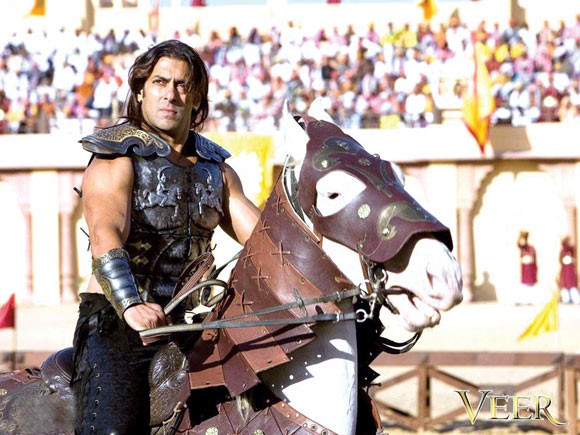
Salman Khan in the title role of Veer (2009)
Veer, who is sent to study in London, finds his nationalist consciousness awakened, and leads the Pindaris, as well as the enemy kingdom of Madhavgarh, to fight the British. He also falls in love with and marries Gyanendra’s anglicised daughter.
At first, there are several external markers of the tribal identity here. The men sport untamed manes and furry clothes—on one occasion, Veer wears something like a furred hoodie. The women wear chunky jewellery. One tribal number, titled ‘Taali,’ has plenty of drums, foot stomping and heavy beer mugs. But as our hero embarks on his scholarship, sponsored by a “Lord Macaulay,” he quickly discards the tribal markers. Veer chops off his hair and sheds his coarse clothes for tailored suits. At one point in the film, an Englishman berates Veer and a number of other students from colonised lands assembled in a classroom for their “dirty,” uncivilised ways. Veer’s transformation is, in fact, an enactment of the colonial fantasy of civilising the native, which bears many parallels with the contemporary Indian fantasy of civilising the tribal person into a good citizen. Yet, Veer also realises that the English want to undermine Indians by remaking them into little brown Englishmen, just like King Gyanendra. He decides that the fierce independence of the tribal person must remain untamed.
The film’s depiction of the Pindaris hews to classic Bollywood tropes associated with tribal people. Both the landscapes associated with the Pindaris are certified Bollywood-tribal: when this desert tribe loses their home, they promptly find another wild, tribal landscape, of lush forest, to settle in. Yet another marker of otherness comes through in the absence of writing, and written knowledge, among these pre-modern tribal peoples. “My research showed that tribal cultures do not have writing,” Veer’s director, Anil Sharma, told me over the phone in July 2015. “Which gave me the idea that ‘zabaan’—keeping their word—and honour would be crucial to the Pindaris. For me, these became the defining qualities of the Pindaris.”
Indeed, the gaining of written knowledge is what “civilises” Veer to a large extent. Soon after he reaches London, he writes copious letters home. Through these, he articulates his understanding of the British psyche. His love, Yashodhara, however, is fluent in the written form; this we see in her written messages to her father and Veer.
Sharma himself has what might be described as a subaltern attitude to the written record: he maintains a safe distance from the historical accounts of the Pindaris, which describe them as a merciless tribe of marauders-for-hire. “Woh toh goron ki history hai,” (That’s white people’s history), he told me, chuckling. “You have to read and understand for yourself. What I saw was that the Pindaris always looted the British.”
Setting Veer in the colonial period provided an obvious nationalistic discourse for it. The British are evil colonisers; “Indians,” a vaguely defined category, are their acolytes. The Pindaris, in the film, are the wronged tribe, led into the light of national consciousness by their educated hero. Veer does gain much from his encounter with the British: travel, education, a more sensible hairstyle. Nevertheless, his anger is directed primarily against the Raj, and not the kingdom of Madhavgarh, which actually displaced the Pindaris from their homeland. That, the film contends, is how much he loves India. In a film about the same subject from another era, it would be a mainstream, dominant-class person who co-opted the Pindaris into the freedom movement. Here, the positions are reversed, and the Pindaris lead the anti-colonial charge.
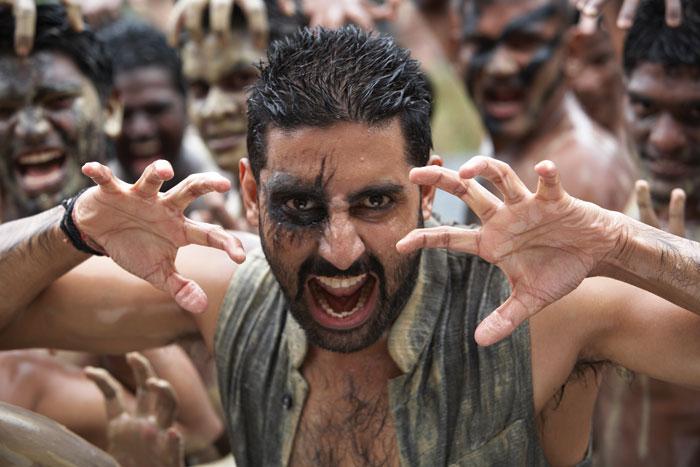
Abhishek Bachhan in the title role in Mani Ratnam’s Raavan. This is a still from the song Thok de Killi
MANI RATNAM’S RAAVAN (2010) tackles nationalism very differently from, and far more astringently than, Mary Kom and Veer. The film reconfigures the Ramayana to cast the demon king Raavan as the unambiguous hero, a larger-than-life man of justice and honour, while Ram, the ideal man, is merely law-abiding and righteous. When Beera (Raavan) kidnaps Ragini (Sita), the wife of the police officer Dev (Ram), hostilities escalate between the police and the people of Lal Maati, a forested area that Beera administers with fierce love and strange facial expressions. The police are powerless there—they don’t know their way about the forest—and Beera’s men are ruthless with the policemen they encounter in their area. But Beera is drawn to Ragini’s conviction and fury, and lets her go, unhurt. In an inversion of the narrative of the Ramayana, Dev tricks her into locating Beera, and then shoots him. But Beera falls to his death with the happy knowledge that Ragini rushed to try and save him from the bullet.
Beera Munda is a recognisably adivasi name, bringing to mind the legendary tribal freedom fighter Birsa Munda. Beera’s physical appearance, however, is not easy to classify. He is costumed in contemporary clothes—most often a kurta, trousers and a large shawl—in the fashion of long-time Jawaharlal Nehru University students who refuse to hand in their dissertations. He wears no jewellery, or feathers, and generally no face paint. But like that old joke where the woman tells her friend to bare her breast when the National Geographic photographer shows up, Beera smears mud on his face when he poses for a photograph to be sent to the police. In other words, he enacts the tribal persona, or the Naxal, or both.
Lal Maati is a wild, velvet forest where the rain is ceaseless. Early in the film, a bare-bodied Beera is framed at the rocky precipice of a sheer drop, looking down steadily before he dives down into a river. He is one with the rugged land, the scene suggests; he owns this terrain. When he is shot by Dev, he drops down a similar precipice in slow motion.
The rockscape enfolds him. Again and again in the film, Beera appears seemingly out of nowhere, leaping, running, crouching—a child of the forest, master of its secrets, king of its camouflages. There is a sense of the superheroic about Beera. He dives intrepidly from cliffs, he fights across a precarious burning bridge, and even when the police launch a manhunt, no one can touch him; he has to be tricked to be felled.
The film has one full-fledged tribal number, ‘Thok de killi,’ replete with energetic drums, equally energetic dancing, and the requisite unintelligible catchphrase. “If you look up the lyrics, you’ll see how it articulates the marginality of adivasis,” Baradwaj Rangan, a film critic and the author of the book Conversations with Mani Ratnam, told me.“Aaja mil ke bethain, haal suna dain dil ka, kela wo khaate hain, hamko phenkain chilka chilka”(Let’s sit down all together, speak of the things that pierce our hearts, that they eat up the bananas, and toss the skins our way). It’s a curious thing, this song—it conforms to the trope of the tribal number, but turns it into an expression of protest. “This is possibly the film’s most political moment,” Rangan said.
On the one hand is the state, and on the other, those who are labelled anti-nationals—in this case, tribal people rising in Maoist-style struggle. Ratnam argues that the bogey of anti-nationalism is raised by an arrogant, immoral state, and that if anyone speaks for the nation, or some of its citizens at any rate, it is Beera. While some might argue that Raavan is an anti-India film, it is, if anything, an anti-government film.
of the four films, 3 Idiots is the most covert about its tribal-identity hero, and the nationalist discourse that accompanies him. The story unfolds in a prestigious national institute of engineering studies, a fictionalised version of the Indian Institutes of Technology. Two of the protagonists, Farhan and Raju, are batch-mates and friends. Ten years after graduating, they go on a road trip to search for their third best friend, and fellow batchmate, Rancho—a caring genius who disappeared after fixing their lives and laying bare the problems with their university and education system. “Rancho” is a nickname for “Ranchhoddas Chanchad,” but at the film’s end, we learn that this is not his true name at all—he is Phunsukh Wangdu, a Ladakhi who impersonated a rich man’s son, named Ranchhoddas Chanchad.

Aamir Khan as Phunsukh Wangdu in 3 Idiots!
Chanchad is a Gujarati name, and the film plays on this through a comedic sequence featuring a drunk Kareena Kapoor holding a plate of dhokla. But “Phunsukh Wangdu” is never mapped in terms of identity. Indeed, 3 Idiots never articulates whether Wangdu is of tribal identity. Rancho dresses and looks no different from the others. He also speaks Hindi well, unlike the Tamil character Chatur. Rancho is mainstream in name, appearance and language.
There are non-visual cues, however, that Rancho might be a tribal person. For one, the search for Rancho takes us far away from the city and deep into the hills. Over the opening credits, the car carrying two of the three “idiots” winds up curved roads, a dot amid the mountains, and the song ‘Behti hawa saa thha woh’ (he was like the flowing wind) playing in the background. This song is the second cue. It elaborates on nature, on the idea of refreshing difference, and plays at critical junctures in the plot to evoke Rancho. As the plot progresses, the film goes farther into the mountains. Its first stop is the hill capital of Shimla, but this is a red herring. The search ends in the landscape of Ladakh—a fairly remote location in Hindi cinema for a plot to unfold.
In a school deep in the hills, next to an improbably blue Pangong lake, we meet again the improbably boyish Rancho, who we learn is really Phunsukh. The change of landscape is a succinct subtext: only in this pristine mountain land can our hero be himself. Away from here, he is someone else.
The heroes in each of these major new films are marked by two defining characteristics. First, they are exceptional outliers. Second, they are patriots. Mary Kom’s career is exceptional—the inherently nationalising theatre of sport casts her as an extraordinary Indian. Veeris a feared warrior, and a patriot who awakens even the enemy kingdom to rise up to the greater enemy, the British. Rancho is a genius and a maverick, who shuns big money to live in the wilderness and teach children. Raavanstretches the meaning of patriotism, but it’s quite clear that Beera speaks for those pockets of the nation that the government has no time for. His commitment to his nation is not in question; he objects to the indifference, and the excesses, of the state. With the exception of Yeh Gulistan Hamara, the older films do not carry a nationalist message.
In the new films, the nation furnishes the convenient category with which to reclaim the tribal other. You are a part of this country, these narratives emphasise, so you are one of us. But Raavan does resist this neat analysis. Ratnam pitches Beera as the wronged leader of a beat-up people, unloved of this country. This flips the premise of a film like YehGulistan Hamara, which calls for the integration of the tribal other. Raavan instead speaks of how the Indian state has excluded many of its people.
The new tribal heroes may not look different or dress differently from the regular heroes, but they are set apart in an important way—by their superheroic personas. The multiplex era in Bollywood has explored smaller, humbler subjects with slighter, more modest, heroes. Cue the rise of several genres—the male bromance, the small-town film, the indie flick, the mad comedy, among others—films whose protagonists are allowed to be a little silly, a little lazy, sometimes afraid, sometimes even mean. Meanwhile, the tribal hero has been locked into bloated overachievement, robbed of the rich, complex range of human failings, conceits and vulnerabilities.
It seems to me an unusually high bar to set for representation: that a tribal Bollywood protagonist must not only be a devoted nationalist, but also a genius and superhero. It is an uneasy reminder of another kind of hero in new Hindi cinema: the good Muslim. This is not the old Muslim hero of period pieces—the princes and nawabs in courtly dramas like Anarkali, Mughal-e-Azam and Pakeezah. Those films, by their very definition, did not represent the contemporary. Through the 1990s and the 2000s, the Muslim hero returned in a more contemporary avatar—that of the tortured militant anti-hero in the context of the insurgency in Jammu and Kashmir, the growth of Hindutva politics in the country, and the aftermath of the September 2001 militant attacks in the United States. This is what we see in the films of the last ten or 15 years, such as Fiza, Mission Kashmir, Fanaa, Kurbaan, New York and Haider.
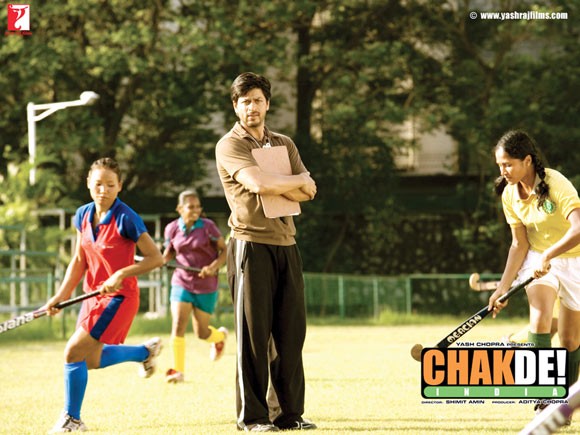
Shahrukh Khan is the impossibly good Muslim hero in Chak de India! (2007), a prototype he would take several degrees further in 2010 in the film My Name is Khan
The good Muslim hero is more recent, emerging in the face of anti-Muslim sentiment after 2001. We start noticing him from 2007, when, in Chak De! India, Shah Rukh Khan’s disgraced hockey player finds redemption in coaching the women’s team to become world champions. Later, in My Name is Khan,Iqbal, and most recently in Phantom, the Muslim hero is constructed much like the new tribal hero—the unquestionable patriot, and, always, impossibly heroic. (My Name is Khan and Iqbal feature protagonists who are additionally superheroic for “overcoming” their disabilities.) But while at least some of these tightly regulated Muslim roles are performed by Muslim actors, none of the roles of tribal heroes have, so far, been entrusted to tribal actors.
The recent release of another, more worrying, film, however, put the new Bollywood tribal hero into perspective. This was MSG2 (2015), which had Sant Gurmeet Ram Raheem Singhji Insan, the head of the religious organisation Dera Sacha Sauda, in the capacity of director, lead actor, writer, composer, singer and lyricist. If Baahubali set this essay into motion, MSG2 settled it. The film was released amid a terrific onslaught of publicity, taking over YouTube homescreens and FM airtime. It was reviewed by every major media outlet, likely in anticipation of its potential to be so-bad-it’s-good.
In the film, the mission of the character played by Insan, referred to as Guruji, is to civilise the “adivasis,” as the film terms them. When we see them first, they don’t brush their teeth or clip their nails, and they wear leopard skin itsy-bitsies and shell jewellery. They shoot arrows with skill, and carry away cattle from neighbouring agricultural villages to eat them raw. They loot buses and swing from trees. So when the state government declares them “terrorists,” supposedly civilised, agriculture-practising villagers distribute sweets to celebrate the imminent army operation against them. Insan decides to step in, declaring, “In adivasiyon ko main sudhaaroonga” (I will improve these adivasis). At different points in the film, the adivasis are called jaanwar, raakshas, shaitaan—animal, demon, monster. The characters’ names are revealing, too. The most dangerous adivasi antagonist is called Ajgar, which means python in some Indian languages.
One thing is clear: the tribal people are not insaan, or human, while the guru’s last name clearly denotes that he is. Insan must teach them hygiene, agriculture, animal husbandry, sewing, the dangers of child marriage, and a healthy lifestyle sans meat, alcohol or tobacco. It goes without saying that well before the end, the adivasis are reformed. In the film’s most striking moment, when one village of adivasis launches into a tribal number in Insan’s honour, he stops them. “Pehle kapde pehenke aao, phir hamein dance dikhaana”—wear clothes first, then show me the dance. When the dancers come back, they are dressed in saris and kurta-pyjamas, no different from the people of mainstream India.
Hindi cinema has never stopped tribal dancers mid-song, to ask that they change and come back. Bollywood, in fact, so loves the tribal number, and costume, that it has fetishised them into stereotypes. The message in MSG2 is far more condescending, and worrying. It bespeaks a future in which tribal people must be remade entirely, from what they eat and drink, down to how they dress and dance.
(This essay was published in Caravan magazine in February 2016)
Film images taken from the essay on Caravan and from Google on the principle of non-commercial sharing